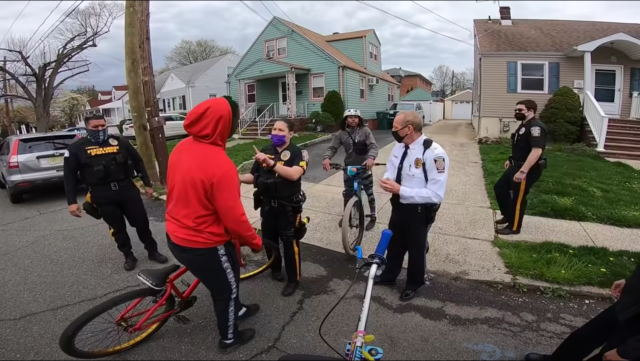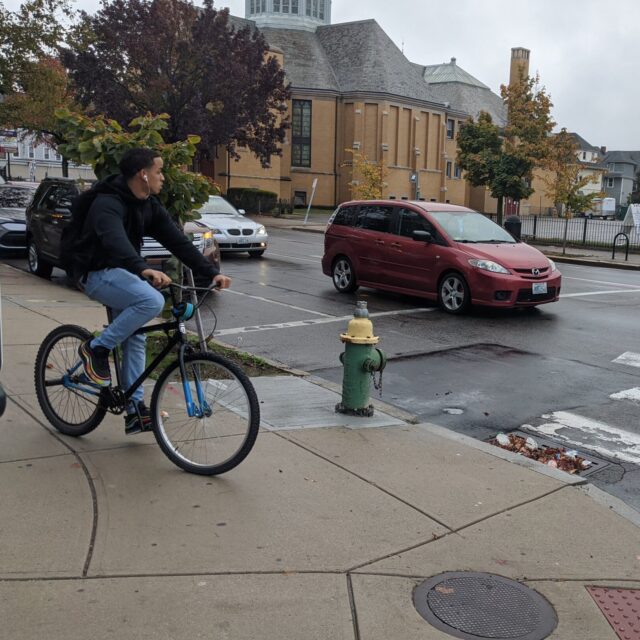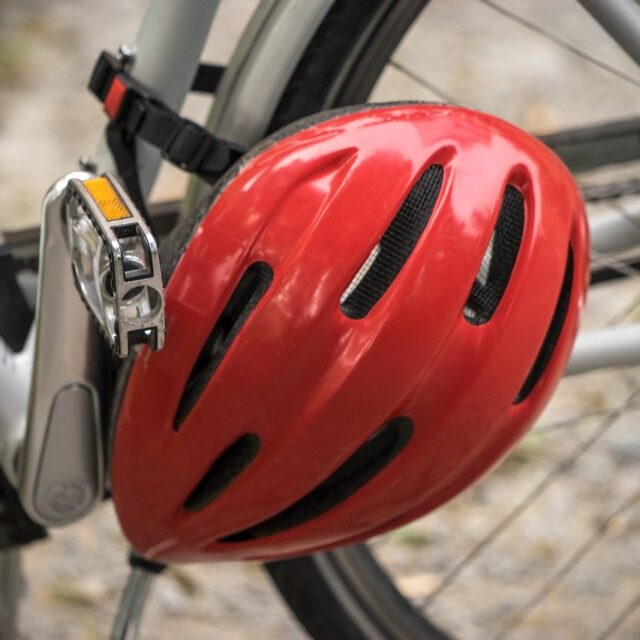Removing Enforcement from Transportation
by Kiran Herbert, Communications Manager
April 28, 2021
A three-part series from the Transportation Equity Caucus dives into the history of enforcement, the current landscape and a vision for the future.

A screenshot from a viral video taken two weeks ago in Perth Amboy, New Jersey.
Last week, a video of New Jersey police officers confiscating four bikes from a group of primarily BIPOC teens—and putting one of them in handcuffs—went viral. The crime? The teens didn’t have bike licenses. Bicycle licensing, registration and helmet laws can be found throughout the U.S., and although many places choose not to enforce them, they’re disproportionately used to target Black and brown bodies.
What we saw in New Jersey last week is unfortunately not new, but rather part of a historical and ongoing issue researcher Charles T. Brown has dubbed “Arrested Mobility.” From “routine” traffic stops to tickets for jaywalking, minor offenses have the potential to become major incidents, inflicting psychological trauma on historically marginalized communities even when there are no physical consequences. Last December, in order to promote the removal of enforcement from transportation programs, the Transportation Equity Caucus launched a three-part webinar series, “Removing Enforcement Strategies from Transportation Safety Programs.”
The videos, which focus on the history, the current state of affairs, and alternative methods of enforcement, offer a vital crash course on how the role of police in transportation harms the most vulnerable of Americans, including BIPOC, low-income individuals and those with disabilities. Even if you’re already familiar with the history of U.S. law enforcement and how it continues to be a systemic way to police BIPOC lives, the discussions, full of personal anecdotes and powerful messages of resistance, are worth watching. All three serve as an example of what a more inclusive transportation system might look like, where we acknowledge the shared humanity of all people and create safe spaces that engender meaningful conversation and progress.
Part One: “History of Enforcement in Transportation”
Accompanying Webinar Resources
In order to go about changing that status quo, we have to understand how we got here—and acknowledge the racism that exists and the harm that’s already been done. In the first webinar in the series, Anita Cozart, Deputy Director of the Washington DC Office of Planning, Olatunji Oboi Reed, Founder and CEO of Equiticity, and Río Oxas, Co-Founder of RAHOK, share their lived experiences as people of color navigating public spaces. With moderator Axel Santana of PolicyLink as a guide, these educators, activists and powerful voices lift up the barriers to access and the critical need to make transportation work for everyone.
Part Two:
“What Enforcement Is Now and How It Intersects with Transportation”
Accompanying Webinar Resources
In the second webinar, Dara Baldwin, director of national policy for the Center for Disability Rights, moderates an emotional discussion around what enforcement in the U.S. looks like and the myriad of ways in which it affects transportation. Panelists Keri Gray, founder of the National Alliance of Multicultural Disabled Advocates and Breon Wells, president and CEO of The Daniel Initiative, emphasize the way transportation connects to education, health and poverty. Accountability in policing is an important theme of this webinar, which delivered one especially potent line on the topic: “Qualified immunity is tax-subsidized police misconduct.”
Part Three:
“Redefining Safety: A Vision for the Future of Transportation”
Accompanying Webinar Resources
The final webinar in this series, again moderated by Axel Santana of PolicyLink, looks ahead. Jen Deerwater, founding executive director of Crushing Colonialism, shares damning facts that highlight the unjust effect enforcement has on Indigenous communities in the U.S., while disability justice advocate Justice Shorter emphasizes the important ways in which transportation and enforcement interplay with humanitarian crises, natural disasters and emergency management. Rounding out the panel is Brother Damon, whose work as the director for the Newark Community Street Team showcases an alternative model of community enforcement, and Christopher Scott, a senior policy advisor for education and youth at the Open Society Foundations.
All panelists shared data that zeroed in on issues affecting specific populations, while also taking a macro perspective to discuss why it’s imperative that we redefine public safety to prioritize marginalized groups. As Brother Damon shared, “Safety is not just the absence of crime and violence but it’s the presence of wellness and those institutions that actually help the most vulnerable among us.”
In the end, panelists shared their vision of what a more equitable transportation space might look like:
👉🏾 More bikes, scooters and transportation options for those with disabilities
👉🏾 Systems that protect people, keeping them safe, but that don’t also contribute to the climate crisis
👉🏾 Good infrastructure in all areas, including tribal lands and poor communities
👉🏾 A transportation system that isn’t complicit in white supremacy
👉🏾 A redistribution of funds from the police to communities, who then decide how to allocate those resources
👉🏾 Resident-led, community-based enforcement strategies
👉🏾 Mobility without mortality; a vision that acknowledges the bigger picture as well as the day-to-day challenges of having limited mobility
Many thanks to the Transportation Equity Caucus for hosting and sharing these webinars.
The Better Bike Share Partnership is funded by The JPB Foundation as a collaborative between the City of Philadelphia, the National Association of City Transportation Officials (NACTO) and the PeopleForBikes Foundation to build equitable and replicable bike share systems. Follow us on Facebook, Twitter and Instagram or sign up for our weekly newsletter. Got a question or a story idea? Email kiran@peopleforbikes.org.



